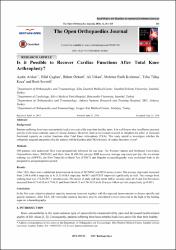| dc.contributor.author | Arslan, Aydın | |
| dc.contributor.author | Çuğlan, Bilal | |
| dc.contributor.author | Özkurt, Bülent | |
| dc.contributor.author | Utkan, Ali | |
| dc.contributor.author | Korkmaz, Mehmet Fatih | |
| dc.contributor.author | Koca, Tuba Tülay | |
| dc.contributor.author | Sevimli, Reşit | |
| dc.date.accessioned | 2019-02-01T12:00:28Z | |
| dc.date.available | 2019-02-01T12:00:28Z | |
| dc.date.issued | 2018-06-21 | |
| dc.identifier.issn | 1874-3250 | |
| dc.identifier.uri | http://hdl.handle.net/11363/1092 | |
| dc.description.abstract | Background: Patients suffering from knee osteoarthritis lead a less active life than their healthy peers. It is well known that insufficient physical activity is the most common cause of chronic diseases. However, there is not enough research to enlighten the effect of increased functional capacity on cardiac functions after Total Knee Arthroplasty (TKA). This study aimed to investigate whether the orthopedic surgeons can predict that the patients will be healthier after TKA in terms of cardiac functions or not? Methods: 109 patients who underwent TKA were prospectively followed for one year. The Western Ontario and McMaster Universities Osteoarthritis Index (WOMAC) and short form 36 (SF-36) surveys, BMI measures, average step count per day, the six-minute walking test (6MWT), the Five-Times-Sit-to-Stand Test (FTSST) and Doppler echocardiography were performed both in the preoperative and postoperative period. Results: After TKA, there was a substantial improvement in terms of WOMAC and SF36 survey scores. The average step count increased from 2199.6±690.8 steps/day to 4124.3±1638.8 steps/day. 6MWT and FTSST improved significantly as well. The average brisk walking time was 174.23±95.11 minutes/week. The means of early and late mitral inflow velocity ratios (E/A and Em/Am ratios) increased from 0.71±0.12 to 0.77±0.13 and from 0.66±0.13 to 0.76± 0.15 at the first year follow-up visit, respectively (p<0.001). Conclusion: In the first year, objective physical capacity measures increased together with the expected improvements in disease-specific and generic measures. After TKA, left ventricular diastolic functions may be considered to have recovered in the light of the healing signs via echocardiography. | en_US |
| dc.language.iso | eng | en_US |
| dc.publisher | The Open Orthopaedics Journal | en_US |
| dc.relation.isversionof | 10.2174/1874325001812010261 | en_US |
| dc.rights | info:eu-repo/semantics/openAccess | en_US |
| dc.rights | Attribution-NonCommercial-NoDerivs 3.0 United States | * |
| dc.rights.uri | http://creativecommons.org/licenses/by-nc-nd/3.0/us/ | * |
| dc.subject | Research Subject Categories::MEDICINE | en_US |
| dc.title | Is it Possible to Recover Cardiac Functions After Total Knee Arthroplasty? | en_US |
| dc.type | article | en_US |
| dc.relation.ispartof | The Open Orthopaedics Journal | en_US |
| dc.department | İstanbul Gelişim Üniversitesi | en_US |
| dc.identifier.volume | 2018 | en_US |
| dc.identifier.issue | 12 | en_US |
| dc.identifier.startpage | 261 | en_US |
| dc.identifier.endpage | 268 | en_US |
| dc.relation.publicationcategory | Kategori Yok | en_US |



















